Stanley Kubrick had already well established his reputation as a maverick genius by the time he began work on 1964’s Dr. Strangelove: or How I Learned To Stop Worrying And Love The Bomb, as well as his equally powerful reputation for polarizing audiences. Although often named among the greatest American filmmakers, Kubrick has equally vociferous detractors—many of whom were the studio executives who had to sign the checks to pay for his visions and were treated like ATMs for their trouble by the maestro—and even his most ardent defenders (i.e. me from about ages 16-30) have to admit one or two of his features were more interesting than good.
All that equivocation goes out the window when discussing Kubrick’s first semi-foray into science-fiction, though: Dr. Strangelove is one of the greatest movies ever made and that’s all there is to it.
Kubrick, in the process of developing a movie about an accident with nuclear weapons, was given the novel Red Alert by Peter George, a fairly sober thriller on the subject, which he used as the template for his film. While working on the script, though, Kubrick was struck by just how ridiculous the entire situation was, as were the participants themselves and even the Cold War in general. Shortly, the serious-minded Cold War thriller became a jet-black farcical comedy, and Kubrick enlisted satirist Terry Southern to help move the picture in that direction.
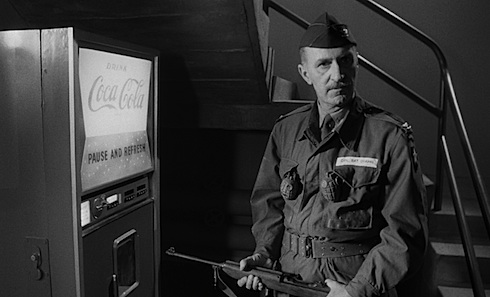
What makes Dr. Strangelove work so well as comedy is that the actors—among whose number are some of the finest to ever suit up—play the absurd text, full of references to Burpleson Air Force base, President Murkin Muffley, and a scientist whose name, before he changed it when he became a U.S. citizen, was Merkwürdig Liebe (get it? Das ist, wie “Strange Love” in Deutsch!) totally straight. Kubrick even went to the extent of not telling Slim Pickens, playing the role of bomber pilot Major Kong, that the movie was a comedy so he’d play the role as earnestly as possible. This approach only serves to make everything funnier. Kubrick stages the action on gigantic, almost Expressionistic sets in long takes with the actors’ movements blocked as if they were onstage, further highlighting the unreality, and his touch with it is true enough that it merges with the “straight” acting to hammer home the ultimate point of the absurdity of the Cold War and nuclear escalation.
The story begins with narration referring to rumors that the Soviet Union is at work on a “doomsday device,” a weapon that will kill everything. We’re introduced, then, to Air Force general Jack D. Ripper (Sterling Hayden), who, under an order intended to be used in case of the entire chain of command being eliminated by a Soviet first strike, sends what looks like the entire Air Force to nuke ’em til they glow. His executive officer (Peter Sellers), an RAF captain in an “officer exchange program,” begins to suspect that Ripper might not be in his right mind, largely do to the fact that he isn’t.
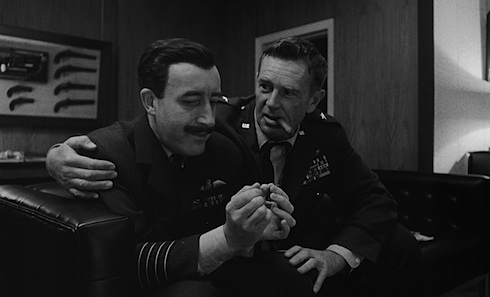
In short order, Air Force General Buck Turgidson (George C. Scott), is summoned to “The War Room” to brief the president (also Peter Sellers) on this situation, leading the president having a couple hilarious phone conversations with a drunk Soviet Premier (reached at his mistress’) about how to deal with the situation. But does their plan take into account the initiative and dogged determination of Slim Pickens and his bomber crew? (One of whom is a very young James Earl Jones, but not so young that he doesn’t have that trademark awesome voice.) And, if all goes horribly wrong and the world is reduced to a lifeless, glowing rock, will the plan cooked up by “ex” Nazi mad scientist Dr. Strangelove (Peter Sellers again) to repopulate the planet with the political and military elite, each of whom will have ten concubines selected for their sexual attractiveness while they spend a century down a mineshaft, work?
Whether it does or not, one thing’s for sure: the movie totally does. It zooms along, its narrative energized by the glorious acting; no matter how over-the-top Sellers, Scott (in particular; his performance is huge), or Hayden get, they never wink at the material, with the possible exception of Sellers’ Strangelove, but by that point everything’s so crazy it’s okay. The ending, which I won’t spoil for anyone who’s yet to see this sprightly, 47-years-young new release, is one of the darkest and funniest ever, and guarantees that you’ll never hear the song “We’ll Meet Again” without seeing Kubrick’s final montage in your mind’s eye. And smile.
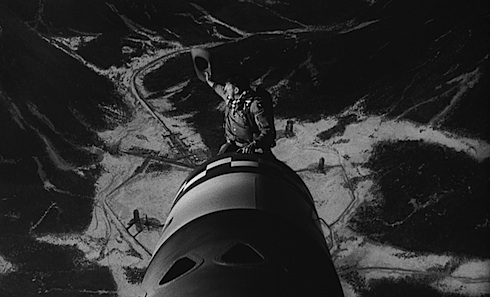
Although not SF itself, Dr. Strangelove does hinge on a science-fictional element, the doomsday machine, and like the best SF it’s just plausible enough to give an audience pause. Kubrick made this picture, let us not forget, only a couple years after the U.S. and Soviet Union almost blew each other up over Cuba, and Nikita Krushchev was going to the United Nations while (reportedly) drunk and banging his shoes on lecterns with his hand. The Cold War was insane. But not so insane that some paranoid at the Kremlin or Pentagon wouldn’t build a doomsday device. George Bernard Shaw said, “When a thing is funny, look for the hidden truth,” and this truth isn’t buried all that deeply. Thankfully, thankfully, since the Cold War ran its course to its much-preferred role as ancient history, it’s a lot easier to laugh at Dr. Strangelove now, but we should never forget, Kubrick wasn’t exaggerating all that much. Like his instructions to the cast, sometimes playing it straight is the best satire there is.
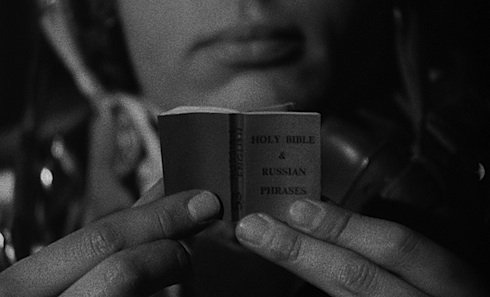
Danny Bowes is a playwright, filmmaker and blogger. He is also a contributor to nytheatre.com and Premiere.com.










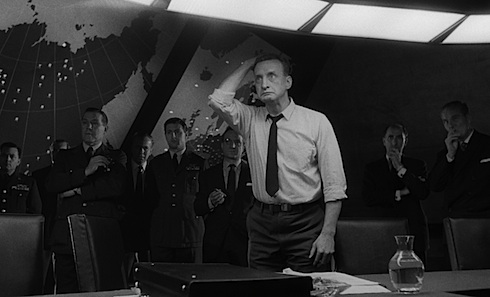
“We must not have! A mineshaft gap!”
George C. Scott doing an awesomely over the top parody of his role in Patton, before he did Patton.
“Yeeeee haaaa!”
What’s interesting is that Dr Strangelove (and that would be Merkwürdigliebe, all one word, as the Germans do) came out in the same year, 1964, as Fail Safe, which is almost exactly the same film, down to the encryption systems and the War Room and the failure modes and everything — except played with deadly seriousness, and which is, really, every bit as awesome in its own right. I don’t know what the story is there, other than a phenomenal coincidence, though I suspect otherwise.
And you can’t tell me that Francis Ford Coppola didn’t have Slim Pickens’s ride on the bomb somewhere in the back of his mind when he choreographed Robert Duvall’s airborne attack in Apocalypse Now.
And, yes, I’d want Henry Fonda for President. Merkin Muffley, not so much.
@NomadUK – Thanks for correcting my German! I think I thought it was his first and last names, or something similarly dumb.
And Fail-Safe vs. Strangelove is basically a dogs vs. cats argument. They’re both great, but no one really loves them equally :)
To my mind, one of the cleverest things about Strangelove is how directly the Slim Pickens and crew thread is inverting a standard war-movie trope; they’re a dedicated crew facing obstacle after obstacle on the way to the mission objective, only the audience sympathies are all with hoping they will be balked by each obstacle rather than overcome it.
I gather the awesome ending is not the originally planned ending, and was suggested, when the originally planned ending was failing to work, by Spike Milligan in conversation with Peter Sellers.
DannyBowes@3: but no one really loves them equally
Well, I do! So there! (All depends on the type of depression and the level of cynicism I’m experiencing that day…)
In a fantastic bit of serendipity, just today I read this discussion of the life of Sterling Hayden, the actor who played General Ripper. Did you know that Hayden was originally a Communist? Or that he was originally a sea captain? Strange but true.
Fail Safe was a very popular novel before being made as a movie, so it is not surprising that Kubrik and Southern knew it and that Dr. Strangelove uses the same plot for satiric effect (and specifically uses the surprise ending of Fail Safe as a throw-away joke when the President is on the phone with the Soviet Premier). Given it’s popularity as a novel, it is also not surprising that Fail Safe was made into a “straight” movie; just wonderful serendipity that they were both done at the same time.
If you watch Strangelove and 2001: A Space Odyssey back-t0-back, you will noticed immediately they share a very strong visual style that features lots of tight close-ups of control panels and screens. The cockpit shots in both movies are very similar, and the recurring focus on Hal’s red camera eye is foreshadowed by the recurring focus in Strangelove on the secure radio that receives the launch/don’t launch command codes.
One other comment: Dr. Strangelove may seem only “kinda” science fiction now, but it was very clearly science fiction when it was made. The doomsday machine is a science fictional device, as you point out, but more importantly there were countless “doomsday” science fiction stories written in those years based on the consequences of Mutual Assured Destruction (the official policy of the United States!) And last, the events clearly take place in the near-future: They certainly could not have taken place in the audience’s past!
Dr Strangelove may or may not have been SF when it was made, but it turned out to be nearly true. There really was a Soviet Doomsday Machine, roughly similar to the one in the film: it was called “PERIMETR” (aka “DEAD HAND”). Essentially it was a system that could be armed in the lead-up to a war and would then proceed to issue launch orders automatically on detecting nuclear detonations on Soviet soil. (Accounts differ on whether this would be a completely automatic process or whether there would still be human launch control officers involved.)
Fascinatingly, this might have been designed not to deter the Americans from a first strike, but to deter the Soviets themselves:
http://www.wired.com/politics/security/magazine/17-10/mf_deadhand?currentPage=4
I remember seeing Strangelove and being mildly put off because I felt like it was ripping off Fail-Safe (I had read the book – don’t think I ever did see the movie.) I guess it still made quite an impression as to this day I like to make obscure jokes about “precious bodily fluids.”
DannyBowes@3
This is because to a dog you are family – to a cat you are staff.
{::posted by the chief of staff for two useless cats::}